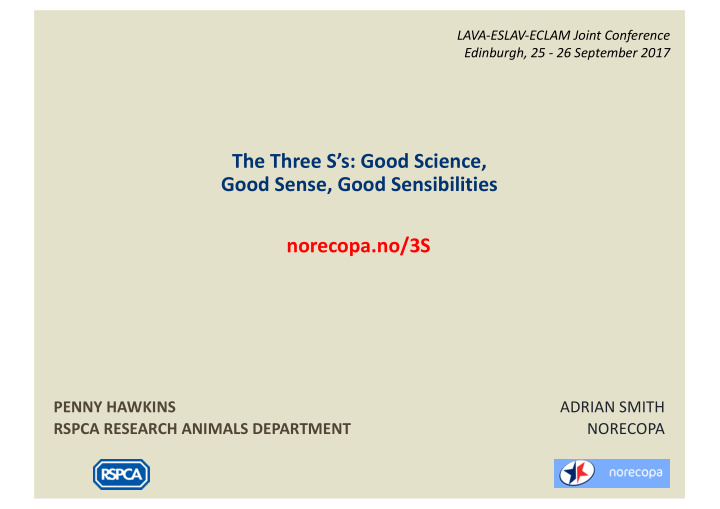



LAVA-ESLAV-ECLAM Joint Conference Edinburgh, 25 - 26 September 2017 The Three S’s: Good Science, Good Sense, Good Sensibilities norecopa.no/3S ADRIAN SMITH PENNY HAWKINS RSPCA RESEARCH ANIMALS DEPARTMENT NORECOPA
The aim of this presentation • To create interest in a set of principles that were never properly published • To give credit to their largely unknown author • To demonstrate their relevance today as an adjunct to the 3Rs
1975 • 16 years after publication of their book, Russell & Burch’s 3Rs (which focused on the humanity criterion) were still attracting little attention • Still 3 years until DH Smyth’s book used the term ‘ Alternatives to Animal Experiments‘ • Generally believed that technology had not advanced sufficiently to be able to replace research animals
1975 • ILAR arranged an international symposium in Washington, D.C. entitled The Future of Animals, Cells, Models and Systems in Research, Development, Education and Testing • the use and limitations of cell, tissue and organ cultures • the application of statistics and computer technology • Carol Newton, Chair of the Department of Biomathematics at UCLA, was an invited speaker
Carol Newton (1925-2014) • PhD in high-energy physics from Stanford • Recognised the need for mathematical models in medicine and biology Photo: NLM • Graduated from medical school in Chicago where she was assistant professor in both medicine and mathematical biology • Chair in Biomathematics at UCLA from 1974 to 1985 • Founding Fellow of the American Institute of Biological and Medical Engineering
“Biostatistical and Biomathematical Methods in Efficient Animal Experimentation” • Challenges of biological variation Photo: NLM • The unknown interactions between variables • ‘The lack of courses that include an interrelated blend of computer, statistical and modelling methods with primary emphasis on their application to real biomedical problems’
Harry Rowsell (1921-2006) (‘THE RIGHT ANIMAL FOR THE RIGHT REASON’) “The ethics of biomedical experimentation” Photo: CCAC • The 3Rs are ‘consistent with the production of valid, meaningful results that, hopefully, will allow replacement of partially successful methods of disease treatment, in both man and animal, with those that are fully effective’ • ‘To the three R’s we may add Carol Newton’s Three S’s: good science, good sense and good sensibilities’ • This is, to the best of our knowledge, the only primary reference
1. Good Science • “Experiments should be designed to reduce the effect of uncontrollable sources of variation [and] to permit effective techniques to be used in their analysis” • Where are we, 42 years on ...? • Does the current culture of scientific research support ‘Good Science’?
Nuffield Council on Bioethics: Culture of scientific research in the UK • Fifty-eight per cent of survey respondents are aware of scientists feeling tempted or under pressure to compromise on research integrity and standards , although evidence was not collected on any outcomes associated with this. • Suggested causes include high levels of competition in science and the pressure to publish . • Training in good research practice is thought to be important in creating conditions that support ethical research conduct. nuffieldbioethics.org/project/research-culture
2. Good Sense • “One certainly must remain mindful of the risk that the ‘correct’ model is not among those being considered” • Challenge whether animal use is valid, translatable and justified, and if so how animals should be used • Common sense, e.g. • dose scaling, admin routes • considering behaviour and biology of the study species
3. Good Sensibilities • Capacity to respond to, or be affected by, emotions and events • ‘Critical anthropomorphism’ • Should reduce contingent suffering, as well as that caused by procedures • Culture of Care ... Photo: Novo Nordisk
Culture of care • The culture of an organisation relates to the beliefs, values and attitudes of its staff and the development of processes that determine how they behave and work together. • A Culture of Care is one that demonstrates caring and respectful attitudes and behaviour towards animals and encourages acceptance of responsibility and accountability in all aspects of animal care and use. norecopa.no/alternatives/culture-of-care
... Culture of Challenge This is about looking for the acceptable, rather than choosing the accepted. The expression "because we've always done it that way" should immediately trigger a (diplomatic) response to evaluate whether they may be better ways of performing the task in question. S Louhimies (2015)
Good science Education and training – good research practice, peer reviewing, ‘laboratory leadership’ Education and training Culture of care, – biology, behaviour moving on to culture and welfare needs of of challenge – active the study species, engagement with and critical & innovative support for individuals thinking, scientific and bodies aiming to method achieve this Good Good sense sensibilities
Recommend
More recommend